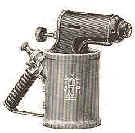|
|
||||||||||||||||||||||||||||||||||||||||||||||||||||||||||||||||
|
History
The soldering technique has been known to man for hundreds, maybe thousands of years. However, with the industrial revolution in Europe as well as North America, the need for higher temperatures and more user-friendly tools emerged. The old methods of heating metals with coal fires etc. were no longer practical. It was discovered that when the vapour from heated alcohol was ignited over a burning wick, it burnt with a very concentrated flame of high temperature very suitable for different heating purposes. Many different designs emerged using this technique and these heating tools were generally called blow pipes. The first known patent is from France and is dated January 7, 1791. Another early blow pipe patent comes from USA and is dated May 13, 1856. The first blow pipes Another early method to create a hot flame suitable for soldering was to blow a fine stream of air over a burning wick. The air stream was created by blowing in a mouthpiece or by different pump arrangements. None of these blow pipes were suitable for soldering, brazing or other heating operations that required more heat or bigger flame. However, the principle was used for many years for smaller soldering and melting operations and quite a few designs were produced by several manufacturers of which some only specialised on this type. You can say that these blow pipes were the predecessors to the modern blow lamp as we know it today. The early blow lamps In 1882, a new vaporising technique was developed by C. R. Nyberg in Sweden and the year after, the production of the Nyberg blow lamp started. The new blow lamp technique and design developed by Nyberg was quickly adopted by a lot of other manufacturers both in Sweden and rest of Europe and later on also in other parts of the world. At the turn of the century, a number of new blow lamp manufacturers emerged and new designs and developments were quickly copied by other manufacturers. In USA however, the "European" blow lamp design was seldom copied and instead a very special "American" design was developed with the distinct flared bottom that can be seen in the picture further down on this page. Most of the American blow lamps are designed to be used with gasoline as fuel but in Europe also kerosene became popular mainly due to safety reasons but also because of the lower price of kerosene. The blow lamp industry is booming During the early 1900`s, a great variety of blow lamps specially designed for different purpose and applications came on the market. Instead of heating the soldering irons with a blow lamp, special self heating soldering irons were developed as well as self heating branding irons. The success in Europe for the crude oil engines required blow lamps of different designs to be used as starting aid. Other examples are special designs for burning off paint where the paint surface would not be exposed to the open blow lamp flame. Again another design would be used for burning off weed were the user could walk upright during work. New models are being added A numerous of different angles of the burners as well as size of burners and fuel tanks came on the market ranging in volume from about 0,1 litres up to about 30 litres capacity. The big ones had the fuel tank and the burners connected with a long hose so that the operator didn't have to move the tank that often. Another example is the special models for auto technicians with its flat fuel tank enabling it to fit easily in the toolbox. To heat up the glow bulb on a crude oil engine, a common blow lamp had been used but when these engines got two cylinders a special blow lamp with double burners was developed. The blow lamp was basically used for heating but also other usage emerged like using it to detect refrigerant leakage. It works on the principle that blow lamp flame changes colour from blue to green when refrigerant is mixed with the combustion air. During the 1930´s, the big blow lamp manufacturers had several hundred of different models in production and most industrial countries had their own blow lamp industry. The biggest being USA, England, France and Germany with several hundred different makes. Other countries like Sweden with a smaller domestic market managed to build up a well known blow lamp industry thanks to its export world-wide. Propane gas is being introduced After the Second World War, the propane gas emerged as a cleaner and safer fuel for different heating purposes. The blow lamp (as well as the pressure stove and pressure lantern) was suffering a bad reputation due to accidents and cumbersome starting procedure (pre-heating required) and the new fuel was quickly growing in popularity. The introduction of propane caused a lot of changes in the blow lamp industry world-wide. Some companies managed to change their production to this new fuel and are still in business. Several mergers took also place in the industry during this period. However, in Europe and in USA, most manufacturers of the old type of blow lamp, using gasoline or kerosene as fuel, had disappeared during 1970´s. However, still today, there are several manufacturers producing the old brass blow lamp in countries like India, China and Korea, to be sold to markets where propane gas is difficult to find or is too expensive. And the design is identical to what it was more than 100 years ago.
|









 A
modern range of Tieta blow lamps made in China.
A
modern range of Tieta blow lamps made in China.